Blog & Latest Updates
Fly Fishing Articles
Insects by Common Name


Arthropod Class Insecta (Insects)
Taxonomic Navigation -?-
1 order isn't included.
Common Name
| Match | Common Name |
| Insects |
This is page 54 of specimens of Insecta. Visit the main Insecta page for:
- The behavior and habitat of Insecta.
- 114 underwater pictures of Insecta.
Pictures of 1229 Insect Specimens:
Caenis (Angler's Curses) Mayfly Nymph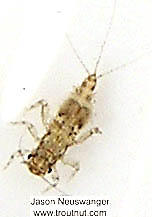 View 2 PicturesI confirmed the identity of this nymph by looking at it under a microscope to be certain of the shape of its gills and head.
View 2 PicturesI confirmed the identity of this nymph by looking at it under a microscope to be certain of the shape of its gills and head.
 View 2 PicturesI confirmed the identity of this nymph by looking at it under a microscope to be certain of the shape of its gills and head.
View 2 PicturesI confirmed the identity of this nymph by looking at it under a microscope to be certain of the shape of its gills and head.Collected January 31, 2004 from unknown in Wisconsin
Added to Troutnut.com by Troutnut on January 25, 2006
Added to Troutnut.com by Troutnut on January 25, 2006
Gomphidae Dragonfly Nymph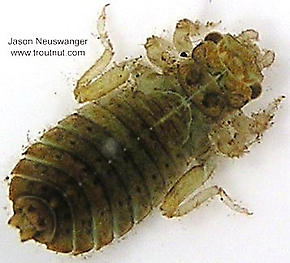 View 3 Pictures
View 3 Pictures
 View 3 Pictures
View 3 PicturesCollected January 31, 2004 from unknown in Wisconsin
Added to Troutnut.com by Troutnut on January 25, 2006
Added to Troutnut.com by Troutnut on January 25, 2006
Caenis (Angler's Curses) Mayfly Nymph View 3 PicturesI confirmed the identity of this nymph by looking at it under a microscope to be certain of the shape of its gills and head.
View 3 PicturesI confirmed the identity of this nymph by looking at it under a microscope to be certain of the shape of its gills and head.
 View 3 PicturesI confirmed the identity of this nymph by looking at it under a microscope to be certain of the shape of its gills and head.
View 3 PicturesI confirmed the identity of this nymph by looking at it under a microscope to be certain of the shape of its gills and head.Collected January 31, 2004 from unknown in Wisconsin
Added to Troutnut.com by Troutnut on January 25, 2006
Added to Troutnut.com by Troutnut on January 25, 2006
Claassenia sabulosa (Golden Stone) Stonefly Nymph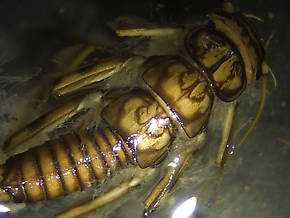 View 2 Pictures
View 2 Pictures
 View 2 Pictures
View 2 PicturesCollected February 1, 2008 from the Flathead River-upper in Montana
Added to Troutnut.com by Bnewell on June 27, 2011
Added to Troutnut.com by Bnewell on June 27, 2011
Caenis (Angler's Curses) Mayfly Nymph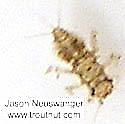 View 2 PicturesI confirmed the identity of this nymph by looking at it under a microscope to be certain of the shape of its gills and head.
View 2 PicturesI confirmed the identity of this nymph by looking at it under a microscope to be certain of the shape of its gills and head.
 View 2 PicturesI confirmed the identity of this nymph by looking at it under a microscope to be certain of the shape of its gills and head.
View 2 PicturesI confirmed the identity of this nymph by looking at it under a microscope to be certain of the shape of its gills and head.Collected January 31, 2004 from unknown in Wisconsin
Added to Troutnut.com by Troutnut on January 25, 2006
Added to Troutnut.com by Troutnut on January 25, 2006
Limnephilus (Summer Flier Sedges) Caddisfly Larva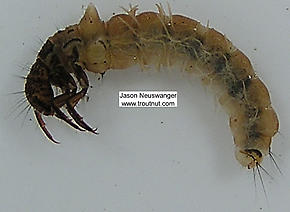 View 2 Pictures
View 2 Pictures
 View 2 Pictures
View 2 PicturesCollected January 31, 2004 from unknown in Wisconsin
Added to Troutnut.com by Troutnut on January 25, 2006
Added to Troutnut.com by Troutnut on January 25, 2006
Ephemerellidae (Hendricksons, Sulphurs, PMDs, BWOs) Mayfly Nymph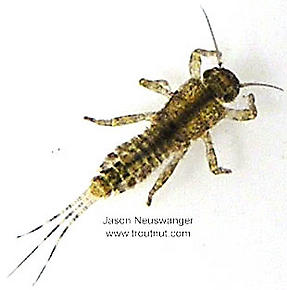 View 2 PicturesClose examination of this specimen under a microscope reveals that it has small rounded tubercles (
View 2 PicturesClose examination of this specimen under a microscope reveals that it has small rounded tubercles (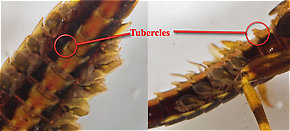 Tubercle: Various peculiar little bumps or projections on an insect. Their character is important for the identification of many kinds of insects, such as the nymphs of Ephemerellidae mayflies.) on the tergites (
Tubercle: Various peculiar little bumps or projections on an insect. Their character is important for the identification of many kinds of insects, such as the nymphs of Ephemerellidae mayflies.) on the tergites (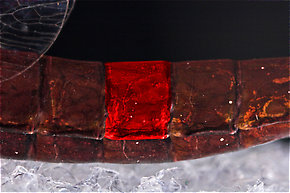 Tergite: The top (dorsal) part of a single segment on an insect's abdomen when it consists of a single chitinous plate (sclerite), or an individual sclerite if the segment has more than one.) and the tails are uniformly covered with short black hairs. Looking at this specimen a while later, my early observations were probably not relevant because it was such as small early instar (Instar: Many invertebrates molt through dozens of progressively larger and better-developed stages as they grow. Each of these stages is known as an instar. Hard-bodied nymphs typically molt through more instars than soft-bodied larvae.) mayfly that its identifying characteristics were not fully developed.
Tergite: The top (dorsal) part of a single segment on an insect's abdomen when it consists of a single chitinous plate (sclerite), or an individual sclerite if the segment has more than one.) and the tails are uniformly covered with short black hairs. Looking at this specimen a while later, my early observations were probably not relevant because it was such as small early instar (Instar: Many invertebrates molt through dozens of progressively larger and better-developed stages as they grow. Each of these stages is known as an instar. Hard-bodied nymphs typically molt through more instars than soft-bodied larvae.) mayfly that its identifying characteristics were not fully developed.
 View 2 PicturesClose examination of this specimen under a microscope reveals that it has small rounded tubercles (
View 2 PicturesClose examination of this specimen under a microscope reveals that it has small rounded tubercles (
A few (not all) of the abdominal tubercles on this Ephemerella needhami nymph are circled. They are especially large in this species.

One tergite of this Isonychia bicolor mayfly spinner is highlighted in red.
Collected January 31, 2004 from unknown in Wisconsin
Added to Troutnut.com by Troutnut on January 25, 2006
Added to Troutnut.com by Troutnut on January 25, 2006
Limnephilidae (Northern Caddisflies) Caddisfly Larva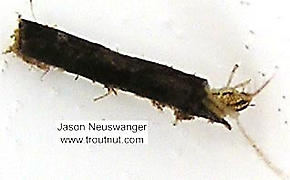 View 2 Pictures
View 2 Pictures
 View 2 Pictures
View 2 PicturesCollected January 31, 2004 from unknown in Wisconsin
Added to Troutnut.com by Troutnut on January 25, 2006
Added to Troutnut.com by Troutnut on January 25, 2006
Ephemerella subvaria (Hendrickson) Mayfly Nymph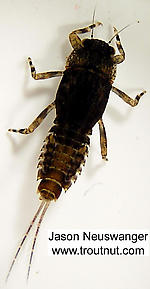 View 3 PicturesThis is one of the nymphs I collected doing something very, very strange on March 17th 2004. In the middle of the day, around 2 pm, in the water right around my feet I watched lots of Ephemerella nymphs clumsily swimming up all the way to the surface and then just kind of drifting and wiggling around in the water column. None hatched. They seemed to do it more intensely when the sun was out. It wasn't the time of day for the normal invertebrate drift phenomenon, and as far as I know invertebrate drift doesn't involve this kind of clear effort to swim all the way to the surface. I didn't need a net to catch them, I just reached down into the water and grabbed them with my fingers just below the surface.
View 3 PicturesThis is one of the nymphs I collected doing something very, very strange on March 17th 2004. In the middle of the day, around 2 pm, in the water right around my feet I watched lots of Ephemerella nymphs clumsily swimming up all the way to the surface and then just kind of drifting and wiggling around in the water column. None hatched. They seemed to do it more intensely when the sun was out. It wasn't the time of day for the normal invertebrate drift phenomenon, and as far as I know invertebrate drift doesn't involve this kind of clear effort to swim all the way to the surface. I didn't need a net to catch them, I just reached down into the water and grabbed them with my fingers just below the surface.
The prominent abdominal tubercles ( Tubercle: Various peculiar little bumps or projections on an insect. Their character is important for the identification of many kinds of insects, such as the nymphs of Ephemerellidae mayflies.) aren't quite black, though, and the general color is a dark brown, though I saw nymphs with all Hendrickson color stages behaving strangely.
Tubercle: Various peculiar little bumps or projections on an insect. Their character is important for the identification of many kinds of insects, such as the nymphs of Ephemerellidae mayflies.) aren't quite black, though, and the general color is a dark brown, though I saw nymphs with all Hendrickson color stages behaving strangely.
 View 3 PicturesThis is one of the nymphs I collected doing something very, very strange on March 17th 2004. In the middle of the day, around 2 pm, in the water right around my feet I watched lots of Ephemerella nymphs clumsily swimming up all the way to the surface and then just kind of drifting and wiggling around in the water column. None hatched. They seemed to do it more intensely when the sun was out. It wasn't the time of day for the normal invertebrate drift phenomenon, and as far as I know invertebrate drift doesn't involve this kind of clear effort to swim all the way to the surface. I didn't need a net to catch them, I just reached down into the water and grabbed them with my fingers just below the surface.
View 3 PicturesThis is one of the nymphs I collected doing something very, very strange on March 17th 2004. In the middle of the day, around 2 pm, in the water right around my feet I watched lots of Ephemerella nymphs clumsily swimming up all the way to the surface and then just kind of drifting and wiggling around in the water column. None hatched. They seemed to do it more intensely when the sun was out. It wasn't the time of day for the normal invertebrate drift phenomenon, and as far as I know invertebrate drift doesn't involve this kind of clear effort to swim all the way to the surface. I didn't need a net to catch them, I just reached down into the water and grabbed them with my fingers just below the surface.The prominent abdominal tubercles (

A few (not all) of the abdominal tubercles on this Ephemerella needhami nymph are circled. They are especially large in this species.
Collected March 17, 2004 from the Namekagon River in Wisconsin
Added to Troutnut.com by Troutnut on January 25, 2006
Added to Troutnut.com by Troutnut on January 25, 2006
Limnophila True Fly Larva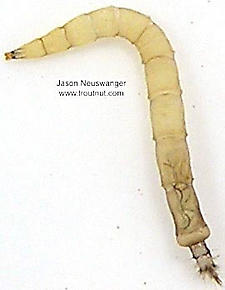 View 2 Pictures
View 2 Pictures
 View 2 Pictures
View 2 PicturesCollected February 2, 2004 from unknown in Wisconsin
Added to Troutnut.com by Troutnut on January 25, 2006
Added to Troutnut.com by Troutnut on January 25, 2006
Top 10 Fly Hatches
Top Gift Shop Designs
Eat mayflies.
Top Insect Specimens
Miscellaneous Sites
Troutnut.com is copyright © 2004-2024 Jason
Neuswanger (email Jason). See my FAQ for information about use of my images.
 privacy policy
privacy policy
